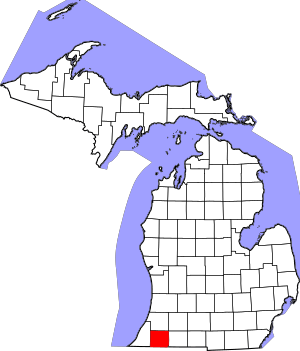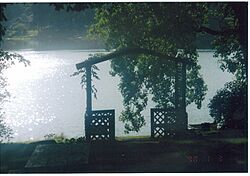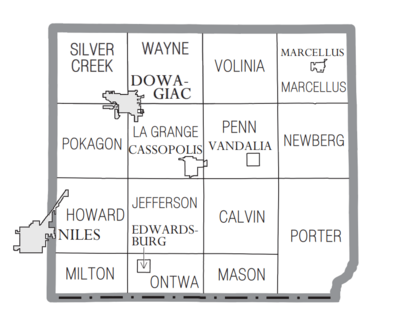Cass County, Michigan facts for kids
Quick facts for kids
Cass County
|
||
|---|---|---|

Cass County Courthouse in Cassopolis
|
||
|
||

Location within the U.S. state of Michigan
|
||
 Michigan's location within the U.S. |
||
| Country | ||
| State | ||
| Founded | 1829 | |
| Named for | Lewis Cass | |
| Seat | Cassopolis | |
| Largest city | Dowagiac | |
| Area | ||
| • Total | 508 sq mi (1,320 km2) | |
| • Land | 490 sq mi (1,300 km2) | |
| • Water | 18 sq mi (50 km2) 3.6%% | |
| Population
(2020)
|
||
| • Total | 51,589 | |
| • Density | 105/sq mi (41/km2) | |
| Congressional district | 5th | |
Cass County is a county in the U.S. state of Michigan. As of the 2020 Census, the population was 51,589. Its county seat is Cassopolis.
Cass County is included in the South Bend–Mishawaka, IN-MI, Metropolitan Statistical Area which has a total population of 316,663 and is considered part of the Michiana region.
Contents
History
The county is named for Lewis Cass, the Michigan Territorial Governor at the time the county was created in 1829. Cass later served as the United States Secretary of War under President Andrew Jackson, thus making a case for including Cass County as one of Michigan's "cabinet counties".
Cass County was not as heavily forested and had more fertile prairie land than other nearby areas of Michigan. During early settlement, it attracted numerous settlers who wanted to farm and grew more rapidly in population.
The county quickly developed industry as well. As early as 1830, a carding mill was started in the county on Dowagiac Creek, a branch of the St. Joseph River. Although the Sauk Trail (Chicago Road) passed through the southern part of the county, early settlement did not come primarily from eastern Michigan. Instead, settlers from Ohio and Indiana migrated who had learned of available prairie lands, reaching the Michigan Territory via a branch of the Chicago Road leading from Fort Wayne, Indiana. The population of Cass County was more than 3,000 by 1834.
Among the most prominent early settlers of Cass County were Baldwin Jenkins and Uzziel Putnam, who both came from Ohio by way of the Carey Mission in Berrien County. Jenkins had been born at Fort Jenkins in Green County, Pennsylvania, and had migrated to Tennessee. He left that state as he was opposed to the institution of slavery. Putnam, who had lived in Massachusetts and New York, migrated to Cass from Erie County, Ohio, by way of Fort Wayne. These settlers, and their families, established the nucleus of the village of Pokagon on Pokagon Prairie in 1825. The next year, a settlement was made on Beardsley's Prairie, where the village of Edwardsburg was laid out in 1831.
The village of Cassopolis was platted in 1831 and intended as the county seat, because it was the geographical center of the county. It had no settlers at the time.
Black settlers
After 1840, the black population of Cass County grew rapidly as families were attracted by white defiance of discriminatory laws, including the Fugitive Slave Law. Numerous highly supportive Quakers helped blacks settle in the area, and the land was low-priced. Free and refugee blacks found Cass County to be a haven, some with mixed Native ancestry, especially Saponi, Lumbee, and Pamunkey. Their development of a thriving community attracted the attention of southern slaveholders.
In 1847 and 1849, planters from Bourbon and Boone counties in Northern Kentucky led raids into Cass County to recapture escaped slaves. They were "surrounded by crowds of angry farmers armed with clubs, scythes, and other farm implements", resisting their attempt.
The raids failed to accomplish their objective but strengthened Southern demands for passage of the Fugitive Slave Act of 1850, which required residents and law enforcement even in free states to support capture of refugee slaves, and increased penalties for failure to do so. Biased toward slaveholders and slavecatchers, it required little documentation and put free blacks at risk for capture and sale into slavery. Many in the North resisted the law, especially in abolitionist strongholds, and it increased tensions contributing to the Civil War.
Cass County became known early on for the anti-slavery attitudes of its population. Pennsylvania Quakers made a settlement in Penn Township in 1829. This community later became a prominent station on the Underground Railroad. One established Underground Railroad route ran from Niles through Cassopolis, Schoolcraft, Climax, and Battle Creek, and thence along the old Territorial Road.
Historical markers
Some 26 historical sites in Cass County have been listed on the National Register of Historic Places and designated by state historical markers as of December 2009.
| Name of Site | City Location | Date Listed | Marker erected |
|---|---|---|---|
| Cass County Courthouse | Cassopolis | 12/14/1976 | 08/17/1977 |
| Cass County Office Building / Masonic Temple | Cassopolis | 07/23/1985 | N/A |
| Centennial Hall Building | Marcellus, Michigan | 03/19/1980 | N/A |
| Chain Lake Baptist Church Cemetery | Calvin Township, Michigan | 12/05/1986 | 04/07/1992 |
| First Methodist Episcopal Church | Dowagiac | 07/18/1996 | 10/12/1999 |
| First Methodist Episcopal Church of Pokagon | Pokagon Township | 04/01/2002 | N/A |
| First Universalist Church of Dowagiac | Dowagiac | 05/30/1984 | 09/08/1982 |
| Jarius Hitchcox House | Union | 12/10/1971 | N/A |
| Indian Lake Cemetery | Silver Creek Township | 03/15/1990 | N/A |
| Carroll Sherman Jones House | Marcellus, Michigan | 03/15/1990 | N/A |
| George Washington Jones House | Marcellus, Michigan | 12/09/1994 | 01/17/1986 |
| Joseph Webster Lee House | Ontwa Township | 03/19/1987 | N/A |
| Mason District Number 5 Schoolhouse | Mason Township | 06/10/1980 | 10/06/1981 |
| Methodist Episcopal Church | Dowagiac | 01/20/2000 | 02/02/2000 |
| Michigan Central Railroad Dowagiac Depot | Dowagiac | N/A | N/A |
| George Newton House | Volinia Township | 11/14/1974 | 10/07/1977 |
| Poe's Corners | Newberg Township | 03/21/1991 | 06/25/1991 |
| Presbyterian Church of Edwardsburg | Edwardsburg | 04/20/2000 | 06/09/2000 |
| Sylvador T. Read House | Cassopolis | 06/10/1980 | N/A |
| Sacred Heart of Mary Catholic Church | Silver Creek Township | 01/16/1976 | 07/19/1977 |
| Smith's Chapel and Cemetery | Milton Township | 04/24/1979 | 04/07/1981 |
| Sumnerville Cemetery | Niles, Michigan | 01/20/2000 | N/A |
| Sumnerville Mounds | Dowagiac, Michigan | 01/20/2000 | 2000 |
| Thompson Road/Air Line Railroad Bridge | Howard Township | N/A | N/A |
| Underground Railroad Informational Designation | Vandalia, Michigan | 01/19/1957 | 04/12/1957 |
| Wayne Township School District No. 7 School | Wayne Township | 04/19/1990 | N/A |
Geography

According to the U.S. Census Bureau, the county has a total area of 508 square miles (1,320 km2), of which 490 square miles (1,300 km2) is land and 18 square miles (47 km2) (3.6%) is water. It is the smallest county in Michigan by total area.
Major highways
 US 12
US 12 M-40
M-40 M-51
M-51 M-60
M-60
 Bus. M‑60
Bus. M‑60 M-62
M-62- M-152
- M-216
- M-217
Adjacent counties
- Van Buren County (north)
- St. Joseph County (east)
- Berrien County (west)
- Elkhart County, Indiana (southeast)
- St. Joseph County, Indiana (southwest)
Demographics
| Historical population | |||
|---|---|---|---|
| Census | Pop. | %± | |
| 1830 | 919 | — | |
| 1840 | 5,710 | 521.3% | |
| 1850 | 10,907 | 91.0% | |
| 1860 | 17,721 | 62.5% | |
| 1870 | 21,094 | 19.0% | |
| 1880 | 22,009 | 4.3% | |
| 1890 | 20,953 | −4.8% | |
| 1900 | 20,876 | −0.4% | |
| 1910 | 20,624 | −1.2% | |
| 1920 | 20,395 | −1.1% | |
| 1930 | 20,888 | 2.4% | |
| 1940 | 21,910 | 4.9% | |
| 1950 | 28,185 | 28.6% | |
| 1960 | 36,932 | 31.0% | |
| 1970 | 43,312 | 17.3% | |
| 1980 | 49,499 | 14.3% | |
| 1990 | 49,477 | 0.0% | |
| 2000 | 51,104 | 3.3% | |
| 2010 | 52,293 | 2.3% | |
| 2020 | 51,589 | −1.3% | |
| 2023 (est.) | 51,642 | −1.2% | |
| U.S. Decennial Census 1790-1960 1900-1990 1990-2000 2010-2018 |
|||
As of the 2010 United States Census, there were 52,293 people living in the county. 88.9% were White, 5.4% Black or African American, 1.0% Native American, 0.6% Asian, 1.1% of some other race and 3.0% of two or more races. 3.0% were Hispanic or Latino (of any race). 25.9% were of German, 10.0% English, 9.6% Irish, 8.1% American and 5.7% Polish ancestry.
As of the 2000 census, there were 51,104 people, 19,676 households, and 14,304 families living in the county. The population density was 104 inhabitants per square mile (40/km2). There were 23,884 housing units at an average density of 48 per square mile (19/km2). The racial makeup of the county was 89.19% White, 6.12% Black or African American, 0.82% Native American, 0.54% Asian, 0.01% Pacific Islander, 1.17% from other races, and 2.15% from two or more races. 2.41% of the population were Hispanic or Latino of any race. 26.6% were of German, 11.1% American, 10.3% Irish, 10.1% English and 5.0% Polish ancestry, 96.4% spoke only English, while 2.0% spoke Spanish at home.
There were 19,676 households, out of which 31.00% had children under the age of 18 living with them, 58.20% were married couples living together, 9.90% had a female householder with no husband present, and 27.30% were not family units. 22.60% of all households were made up of individuals, and 9.40% had someone living alone who was 65 years of age or older. The average household size was 2.56 and the average family size was 2.98.
In the county, 25.50% of the population was under the age of 18, 7.40% was from 18 to 24, 27.60% from 25 to 44, 26.00% from 45 to 64, and 13.60% was 65 years of age or older. The median age was 38 years. For every 100 females, there were 99.90 males. For every 100 females age 18 and over, there were 97.40 males.
The median income for a household in the county was $41,264, and the median income for a family was $46,901. Males had a median income of $35,546 versus $24,526 for females. The per capita income for the county was $19,474. About 6.80% of families and 9.90% of the population were below the poverty line, including 13.60% of those under age 18 and 8.80% of those age 65 or over.
Education
Higher Education
Cass County is home to Southwestern Michigan College. The college is a public two-year institution of higher education, the college is part of the Michigan community college system. The college is the largest employer in Cass County.
Libraries
Cass County has several library system which operate in the county. The Cass District Library is the largest library in the county, have branch located in 4 cities around the county. Cass District Library is the library system which services Calvin, Howard, Jefferson, LaGrange, Mason, Milton, Newberg, Ontwa, Penn, Pokagon, Porter and Volinia Townships.
The Dowagiac District Library serves the City of Dowagiac, Wayne Township, and portions of Silver Creek, Keeler, and Bainbridge townships. Marcellus Township also operates their own library apart from the Cass District library to service the residence of the village of Marcellus and the Township of Marcellus.
Southwestern Michigan College operates the Fred Mathews Library on its Campus in Dowagiac.
Communities


Cities
Villages
- Cassopolis (county seat)
- Edwardsburg
- Marcellus
- Vandalia
Civil townships
- Calvin Township
- Howard Township
- Jefferson Township
- LaGrange Township
- Marcellus Township
- Mason Township
- Milton Township
- Newberg Township
- Ontwa Township
- Penn Township
- Pokagon Township
- Porter Township
- Silver Creek Township
- Volinia Township
- Wayne Township
Unincorporated communities
- Adamsville
- Calvin Center
- Charleston
- Corey
- Glenwood
- Jones
- La Grange
- Penn
- Pokagon
- Sumnerville
- Union
- Wakelee
Indian reservation
- Cass County contains a large reservation of the Pokagon Band of Potawatomi Indians, which also contains territories in Allegan, Berrien, and Van Buren counties, as well as extending south into the state of Indiana. The reservation headquarters are located in the county in the city of Dowagiac and also extends into the townships of Pokagon, LaGrange, Silver Creek, Volinia, and Wayne.
See also
 In Spanish: Condado de Cass (Míchigan) para niños
In Spanish: Condado de Cass (Míchigan) para niños



